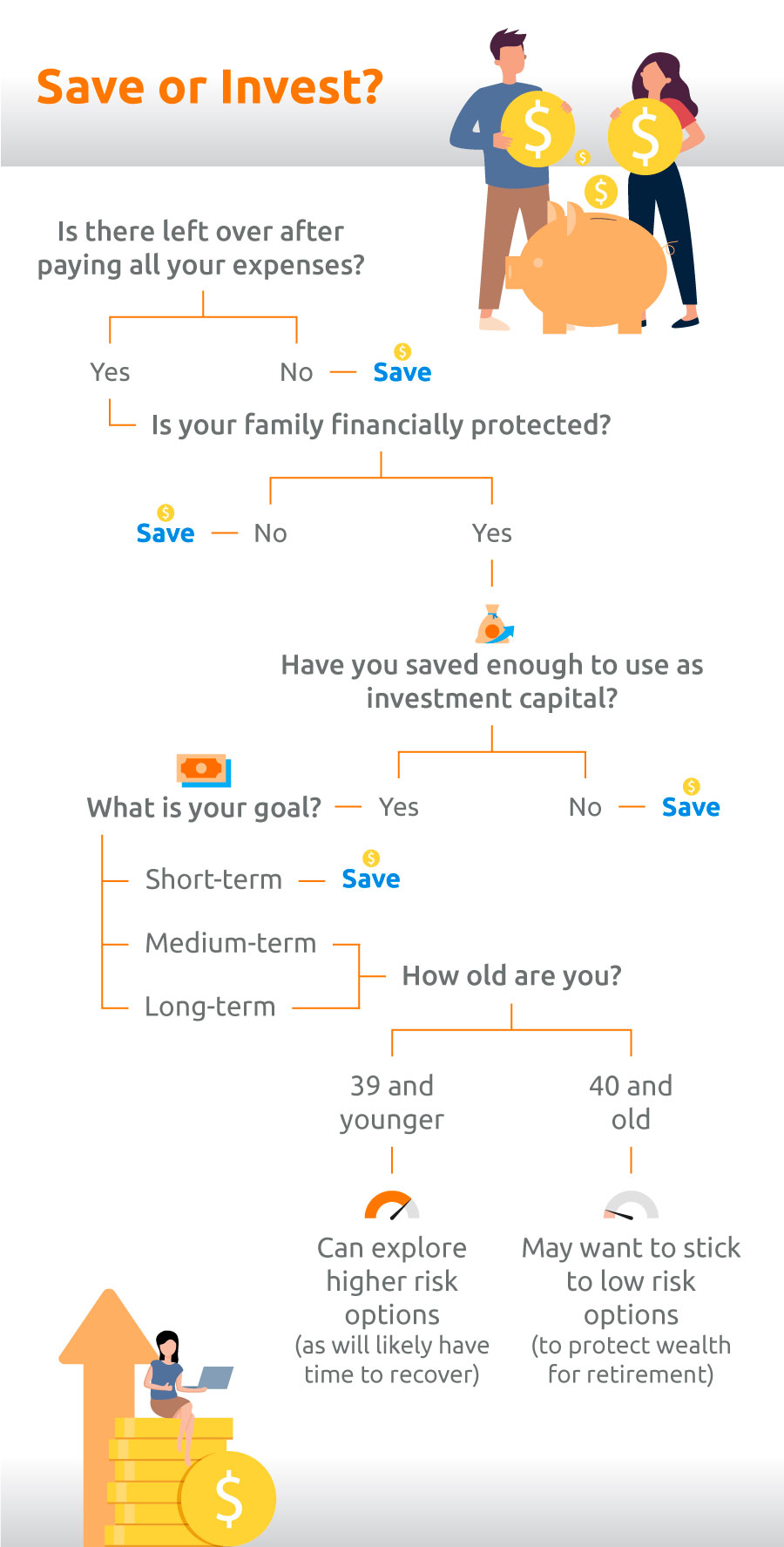Should I Save or Invest?
Good financial health starts with learning how to budget and putting aside money each month for the future. But it doesn’t end there.
Once you do find yourself holding on to a sum of cash, one big question to ask yourself is whether you should continue saving or try investing it instead.
What’s the difference between savings and investing?
Everyone knows what it means to save – it’s usually the first lesson our parents teach us about money. As adults, saving involves regularly setting aside money for the future, usually in a savings account in the bank. It’s a relatively ‘safe’ practice. Your money remains in your account, available for you to use whenever you need it.
Investing, on the other hand, tends to carry some degree of risk. When you invest, you’re using your money to purchase an asset or product that has the potential to give you better returns. These aren’t always guaranteed, but investing does give you the opportunity to increase the value of your money over time.
With saving, your money can actually become less valuable in the long run, since inflations rates tend to be higher than the interest most banks pay on savings accounts. Since low interest rates mean your money isn’t growing, and inflation means that every dollar you have can purchase less each year, leaving your money in a bank account results in the purchasing power of your money diminishing as time passes.
Investing can help you avoid this, either retaining or even raising your money’s purchasing power if the returns are higher than the inflation rate.
How much should I save vs. invest?
Before saving or investing your money, you need to first figure out how much you can afford to put aside. You want to make sure you are able to pay all your expenses, from recurring expenses like mortgage repayments, insurance premiums and utility bills, to day-to-day expenses like food and transport. Make sure all these expenses can be paid before saving or investing what’s left over.
Your next step should be to identify any short-term, medium-term and long-term goals that you are saving or investing for. For short-term goals of five years or less, you might want to consider saving instead of investing for them, as you might not have the time to recover from a loss or poor investment performance. For medium-term or long-term goals, investing is the smarter approach as it can help you achieve your goal more quickly and easily.
But you can’t invest without first saving up your capital. In order to raise this, draw up a budget and track your spending so you can identify any areas where you might be spending more than you need to. Once you’ve gotten your capital ready, then the fun begins!
High risk vs low risk investors
Investing always comes with some degree of risk of losing part or all of your capital. As a general rule of thumb, the higher the potential yield, the higher the risk and vice versa.
Figuring out your risk tolerance is essential to choosing the right investment products. Your risk tolerance will depend on a number of factors, including age, goals, time horizon, financial commitments and personality.
If you are a young, single person in your twenties or thirties whose primary financial goal is to retire three or four decades from now, you can probably afford to take on higher risk than if you are an older person in your fifties who is married with school-age kids, paying off a mortgage and car loan and forsees retirement in less than ten years.
As a young person, you also have time on your side as you have more years to ride out the ups and downs of your investments, as well as recover from losses. So there are clear advantages to starting young when it comes to investing.
Investment types for high risk investors
If you identify as a high risk investor, you can afford to put your money in investment assets that have the potential for high returns.
For instance, some Singaporeans have found success speculating on the real estate market. Such investors typically search for properties which are undervalued or with a high potential to accrue in value, in hopes of being able to sell them at a profit in a few years.
Depending on your investment style, buying stocks can also be high-risk and high-return if you do so in hopes of turning a profit on them in the short-term.
Investment types for low risk investors
Low risk investments enable you to grow your money without having to stress too much over losing it. No matter what kind of investor you are, you might wish to include a low-risk component like insurance in your portfolio in order to mitigate riskier investments.
Income’s insurance savings plans enable you to grow your money over time in a low risk manner, while enjoying life insurance protection for you and your family at the same time. Some plans offer a guaranteed cash value, so you are assured that you will at least get back a certain sum upon maturity or premium term.
Important things to know before you start investing
Investing is one of the most important things you can do for your financial future.
But before you start, it is important to first make sure your family is financially-protected before starting to save or invest. In the absence of financial protection from suitable insurance products, you risk having your savings and investments wiped out if something unfortunate happens to you or a family member. You might want to check out this article for some crucial to-dos before you begin to invest.
Once you’re ready to take that first step, you might consider an insurance savings plan, like Income’s Gro Cash Plus or Gro Cash Sure, or investment-linked plans, like Income’s Invest Flex, Invest Flex Vantage, or AstraLink. Speak to our advisors for help figuring out what would best suit your needs.
This article is meant purely for informational purposes and does not constitute an offer, recommendation, solicitation or advise to buy or sell any product(s). It should not be relied upon as financial advice. The precise terms, conditions and exclusions of any Income Insurance products mentioned are specified in their respective policy contracts. Please seek independent financial advice before making any decision.
These policies are protected under the Policy Owners’ Protection Scheme which is administered by the Singapore Deposit Insurance Corporation (SDIC). Coverage for your policy is automatic and no further action is required from you. For more information on the types of benefits that are covered under the scheme as well as the limits of coverage, where applicable, please contact Income Insurance or visit the GIA/LIA or SDIC websites (www.gia.org.sg or www.lia.org.sg or www.sdic.org.sg).
This advertisement has not been reviewed by the Monetary Authority of Singapore.
.jpg)










